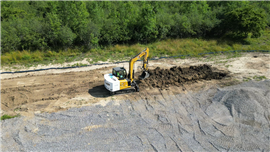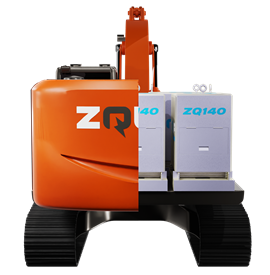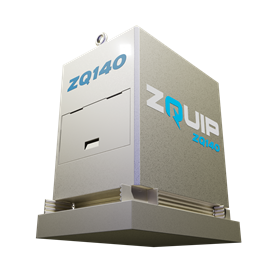Turning diesel-powered construction equipment into zero-emissions machines
05 February 2024
A part of Moog Construction, ZQuip is a new modular energy solution that effectively turns diesel-powered machines into electric equipment. It works on many types of machines, from large excavators to telehandlers and more, helping contractors meet requirements for zero emissions on their jobsites. How do rental companies fit into the plan?
 ZQuip excavator digging at Moog Construction test site in West Seneca, New York, US. (Photo: ZQuip/Moog Construction)
ZQuip excavator digging at Moog Construction test site in West Seneca, New York, US. (Photo: ZQuip/Moog Construction)
There is now a way to turn your larger, diesel-powered equipment into electric machines, thanks to ZQuip, which has launched its modular energy solution with the goal of assisting in creating all-electric job sites.
ZQuip is a part of Moog Construction, which has worked with OEMs in the development of cutting-edge construction technology such as Bobcat’s autonomous Rogue concept. ZQuip’s Conversion Kit turns traditional equipment into zero-emissions machines.
Nominated for an Intermat Innovation Award and introduced at Intermat Paris Press Days in January, ZQuip first demonstrated this concept with a CAT 308, creating a ZQuip battery-electric version of the classic diesel-powered 8-ton excavator, making it one of the most powerful, energy-efficient and zero-emissions 8-ton excavators available today, the company said.
To find out more, we recently spoke to Chris LaFleur, managing director for ZQuip, who told us how the system works and what it could mean for contractors required to use zero-emissions equipment, and for the distributors who rent to them.
RB: What’s the story behind ZQuip?
LaFleur: We asked ourselves, if we were going to start from scratch as an OEM and tackle electrification, what would we do? How would we do it differently than what’s currently being done?
In construction, it all comes down to how much something costs and how much you can get done with it. We realized what’s currently out there is not addressing those two points together.
Currently, every charger doesn’t work with every machine. Every software doesn’t work with every machine. Modularity is the answer.
RB: ZQuip can be used with many types of equipment by fitting a modular battery on the back of each machine. How does that work?
LaFleur: We call it a Conversion Kit, where we still have the same hydraulic system, but the ZQuip Battery Modules, which come in 140- and 70-kWh sizes, power the machine. It’s a zero-emissions way to spin the hydraulic pump. When we convert a machine, we take the tail and the counterweight off, take the diesel engine out, and then we have this blank canvas where we install the conversion kit to the platform, which can then have receptacles for however many battery modules including ballast are needed to get a job done.
Essentially, an electric motor replaces the diesel. A smart controller is the software layer to manage how everything works on the electronic side.
Our battery modules are all enclosed and thermally managed. They maintain a standard temperature that not only keeps them at the optimal operating temperature, but it can also keep them at the temperature you need, so they’re always ready to go.
Our ZE 140 and ZE 70 modules are high voltage, they run between 600 and 800 volts. This allows us to put them into a more compact container, with less wiring. It also gives us the opportunity to look at a size and scale of machines that others wouldn’t.
RB: What does it take to retrofit equipment with this module in terms of cost compared to making an investment in new electric equipment?
LaFleur: If a fleet owner has an excavator that costs $150,000, then an electric model is maybe 40 percent more if they can even get it. New electrical equipment doesn’t exist in a lot of cases. ZQuipping a fleet of machines will cost less than buying new electric models. In Europe they have mandates to do work with zero-emissions machines, but the zero-emissions machines don’t yet exist.
When you have a diesel machine, power is unlimited, you just refuel as needed. When you have batteries, customers are forced to install and pay for the largest number of batteries (e.g., 600 kWh battery packs) they could possibly need; they’re paying for a lot of power they are not going to use. ZQuip couples the amount of energy you need with the task at hand, it makes it economically feasible.
We like to think of our process as two things - it’s the ZQuip Conversion Kit and the Battery Modules. The conversion just gives you the bare excavator or wheel loader, like a hand tool without
 ZQuip 140kW Energy Module on the back of an excavator. (Photo: ZQuip/Moog Construction)
ZQuip 140kW Energy Module on the back of an excavator. (Photo: ZQuip/Moog Construction)
the battery. Customers can then pay for whatever amount of energy they need that day, that week, that month. It suits the customer’s energy needs.
RB: How does this arrangement work for rental companies?
LaFleur: The biggest concern is maintenance. Rental fleets often have multiple brands of equipment with different software technologies, software stacks, maintenance methods, and battery technologies. We have one universal software stack that covers all the different brands of machines, allowing fleet owners to manage their entire fleet universally.
Rental companies also then have control over providing a solution for their customer. So rather than a customer just coming in and saying they need a machine, you can have a better interaction with them... “What do you do? What’s the job? Are you digging dirt, or digging rock? What’s the timeline?”
The rental company embeds itself in their customers’ operations, and then they can provide more value by telling them “You’re going to need this many ZE 140 modules, and this many ZE 70 modules. We’ve got some in stock and we can proactively watch what your machines are doing, and if we see that something is off schedule, we’ll make sure that ZQuip Battery Modules are delivered to you in time.”
We’ve heard this with dealers, we’ve heard this with rental companies, that they feel like they’re losing control over the customer relationship. And that’s understandable because OEMs are still figuring all this out. We’re going right to those distributors and letting them know they are the key. We don’t have our own distribution arm, we want them to be the ones to take ownership of this, and we will enable them to do that.
RB: How have the OEMs reacted to ZQuip?
LaFleur: They know that we’re doing this. The OEMs aren’t competing with us right now. There is nothing on the market that would compete with what we’re doing.
The big OEMs are competing against each other, but in the meantime, the best thing we can do is try to bring something that wins over the customers and the distributors. If the customers prefer our method, and the distributors feel empowered, we can set the standard.
There’s such an extraordinary amount of money being invested in the future of electric equipment. Without a standard and without an agreement on what this future should look like, a lot of that will be wasted.
RB: How does it work on a practical level for rental companies?
LaFleur: We do the engineering on the conversion itself. Once we have that engineering done, it takes about a week to do it for that machine. We work with the fleet owner to determine how many units should be converted, which machine types, etc.
From there, the big opportunity for rental companies is on the battery modules. The machine is rented out by itself, while the module is rented out on an as-needed basis. This gives dealers, rental companies and us a lot of really important data about electric usage. We see our value in helping the distributors with managing their customers.
Moog has facilities all over the world, and we are able to set up service depots at each site, as needed. We can guarantee dealers will have what they need within 24-48 hours, and the dealers can then guarantee that to their customers.
 ZQuip 140kW Energy Module (Photo: ZQuip/Moog Construction)
ZQuip 140kW Energy Module (Photo: ZQuip/Moog Construction)
The other side of modularity is serviceability. Everything that could possibly go wrong with a ZQuipped machine is in a modular system that can be removed and replaced within a few minutes on site. Not only that, but we found that when the diesel engine is removed, it’s easier to work on the existing hydraulic system and other components.
We have the system for providing ZE 140 or ZE 70 battery modules to a rental company’s
customer for what they need on those machines, on that site, for that job. And then rental companies have our backing on the service side, knowing we have replacement parts as needed, that they can support their customers as needed, and that we will be able to guarantee a level of uptime and serviceability that I know nobody else will be able to do.
RB: Any last remarks about ZQuip:
LaFleur: We just want to make it easy and operational and make financial sense to electrify jobsites. This is the way we believe the industry needs to go to succeed.
STAY CONNECTED



Receive the information you need when you need it through our world-leading magazines, newsletters and daily briefings.
CONNECT WITH THE TEAM








